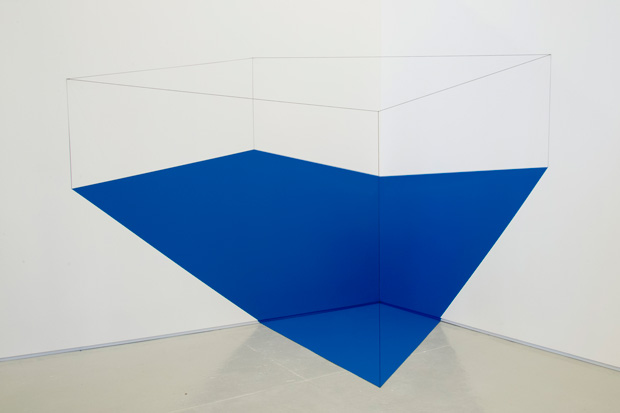Lydia Okumura at Two UB Galleries
Everything is simple and straightforward, and everything is infinitely complex, in the art of Lydia Okumura on show in two University of Buffalo galleries, on the North Campus, and the Anderson Gallery.
Composed of lines and planes—elements of geometry—in transformation. From two dimensions to three. And in reality and in illusion.
Art on the edge between drawing/painting and sculpture. Of Euclidean beauty. Clean and chaste. Distilled to essence.

Drawn and painted lines and planes on paper or canvas—parallels and perpendiculars, floorboards and adjacent walls and corners, angles—and on gallery walls, with taut string from drawn and painted corners across actual corners, wall angles, like drawn lines. On first look likely to be perceived as drawn lines, but on closer inspection, perceived as string. Sculptural material, for sculptural drawing. Enclosing space.
Two dimensions representing three—standard art practice since Classical Greek times, then since the Renaissance—transforming to three dimensions representing two, representing three. And back and forth.
“I do not try to make a space into something it is not,” Okumura says, “but to reaffirm it and to expand its possibilities.”

String is a particular motif, and it is everywhere, around the Anderson Gallery at least. Not just the taut drawn line string enclosing space—causing three-dimensionality, while mimicking two-dimensionality—but copious loose string, slack string, strewn about. On floors, and up and down stairways, and even outside the gallery, on lawns, amid bushes.
One initially suspected poor gallery housekeeping. Or did the strewn about string relate somehow to a particular gallery motif—writ large on a blank wall visible off to the right through the gargantuan wraparound window of the upstairs main exhibit space—the remnant of a previous exhibit that must have seemed so generally apposite to an art venue that it was never removed—in bold letters, the legend: “Reading a Line on a Wall.” Or did it relate somehow to the monumental sheet metal work sculpture visible off to the left, artist David Hayes’s Minotaur. The string Theseus unraveled behind him as he made his way through the labyrinth the prototype artist Dedalus had created to cage the Minotaur—a maze so intricate and complex no one, man or monster, once in, could hope to escape from—enabling Theseus to retrace his path and exit the maze.
A kind of centerpiece work of the Okumura Anderson Gallery exhibit is entitled Labyrinth. Consisting of tall standing upright spirals of painted mesh wire. That you can walk into—to the focal or origin point of the main spiral—and safely out again, absent prior precautionary measures with string or breadcrumbs. But the faintest sense still of inescapable maze. At some point—sometime in the Middle Ages—the labyrinth took on the alternate sense and function of a meditational device—traversing the labyrinth as a meditational experience—and that sense exists as well in the Okumura piece.
Actually—one discovers eventually—the loose string around and about the Anderson Gallery refers primarily to an Okumura piece that undertakes to deconstruct space—as it were—by relating—so to speak—a given spatial volume (a thousand cubic centimeters, or one cubic decimeter) to a given area (one meter squared) to a given length (one kilometer). The strewn string is continuous, and (supposedly) one kilometer in length. (All the parts of this piece—the different modalities, different measures—are clearly labeled—seem to be clearly labeled—though in Portuguese. Okumura is originally from Brazil and made the piece for an exhibit there.)
Among other works in the Anderson exhibit are several finely crafted mesh wire cubic volume forms—boxes, usually but not invariably cubes—containing further cubic volume forms. Beautiful purely aesthetic items. And a bit of a sense of lobster traps. So connection to labyrinths, Dedalus’s and Okumura’s.
The centerpiece work of the North Campus display is a kind of dawn sunburst spectacle decorative wall sculpture, in the usual materials plus glass. It seems to breathe. Label copy likens it to an accordion expanding and contracting.
The North Campus show runs until December 17. The Anderson Gallery show until January 7.

